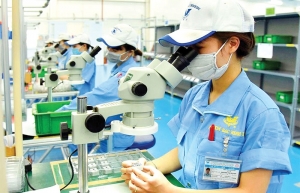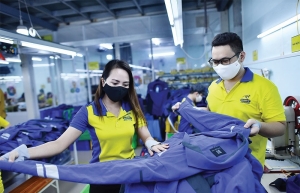Where does Vietnam stand in IP provisions of EVFTA?
Complying with the EVFTA was an opportunity for Vietnam to bring its IP protection regime to essentially the same level as global standards, and importantly, to streamline the trading flows of IP-protected goods between the two regions and more.
 |
| Manh Hung Tran - Managing partner, BMVN and Cam Tu Nguyen Associate attorney, BMVN |
The first regime that saw the change was geographical indication (GI) protection, which has always been the key focus of any European Union’s trade deals. Specifically, in 2019, Vietnam amended its Law on IP of 2005 for the first time in 10 years to set the stage for the automatic protection of 169 European GIs and expand the scope of GI protection in line with the EVFTA.
The Law on IP then underwent a major amendment in 2020, which vastly reflected Vietnam’s effort to comply with the EVFTA and the other free trade agreements taking effect at about the same time. After more than a year and several rounds of public consultation and discussion by the National Assembly, the amended law was finally passed and came into effect in January 2023.
Guiding documents followed suit, with the first being Decree No.17/2023/ND-CP to implement the Law on IP’s provisions on copyright and related rights. With the newly amended law and available legal documents, Vietnam is closer to full compliance with the EVFTA than it was three years ago. Yet, many practical challenges remain.
Vietnam also bears heavy obligations to protect copyright and related rights under the EVFTA. While the standards under the agreement are not new, they require substantial changes to Vietnam’s previous copyright and related rights regime, which was built a long time ago to prepare for Vietnam’s membership of the World Trade Organization.
To comply with the EVFTA, Vietnam must accede into the so-called “Internet Treaties” duo – the WIPO Copyright Treaty and WIPO Performances and Phonograms Treaty; expand the bundle of protected rights (such as reproduction rights and display rights, etc.); provide more effective measures to prevent the circumvention of technological protection measures; and regulate in-depth the “safe harbour” immunity offered to intermediary service providers (ISPs).
This wave of new obligations has no doubt created many practical difficulties for both lawmakers and practitioners, who have been grappling to understand the nature and extent of these obligations. A clear example of this is the regulation of ISP safe harbour. Under the safe harbour, ISPs like cloud storage providers and social networking sites can be immunised from infringement liability associated with the contents uploaded by their users if they fulfil certain obligations, such as promptly taking down the infringing content when they are aware of its existence.
The Law on IP, and later Decree 17, follow the same principle, in which the safe harbour will shield ISPs from any joint liability they may share with their users, under the condition that they carry out certain content moderation procedures. This means if the ISPs fail to meet such conditions, the logical consequence is that they will lose their defence and thus, be held liable for infringement of the copyright and related rights granted to right holders under the law.
However, the Law on IP and Decree 17 seem to treat conditions of ISP safe harbour as legal obligations, rather than the conditions to succeed as a defence against infringement claims. They deem failing to satisfy these conditions as an infringement in itself, which may be subject to a separate set of remedies.
Another challenge Vietnam faces in implementing the IP provisions of the EVFTA is enforcing IP rights. The EVFTA requires a robust mechanism to fight against piracy, counterfeiting, and other infringements, from enforcement through civil court cases to border measures. For example, while Vietnam has a customs recording procedure in place as a coordination regime between right holders and customs authorities, the authorities are required under the EVFTA to take a more proactive stance in preventing infringing goods from flowing into Vietnam. This may pose a practical challenge to Vietnamese enforcement authorities, at least in the short term.
The adoption of the EVFTA also faces stagnation due to the delayed rolling out of guiding documents to the amended law. It was passed more than a year ago and has been in effect for over eight months, but Decree 17 is still the only major implementing document available.
The documents related to the right establishment and enforcement of industrial property rights, such as patents and trademarks, are still in draft stage. The current guiding decrees and circulars have, or will soon, become obsolete compared to the substantially changed law.
In addition, there are still issues under the EVFTA not addressed in the amended Law on IP, such as the “genuine use” analysis in considering whether a trademark registration should be cancelled on the ground of non-use. To ensure compliance with the EVFTA, Vietnam may need to provide such issues under a decree or circular. It is thus imperative that the drafting and passing of these new documents be accelerated as much as practically possible.
The challenges Vietnam faces in implementing the IP provisions of the EVFTA are multifaceted, with each aspect having its own set of complexities. Vietnam’s success in overcoming these challenges will depend on its ability to adapt its legal framework and build an effective mechanism to bring the laws to life. This journey towards robust IP implementation is a critical step in realising the benefits of free trade agreements while safeguarding the interests of Vietnam’s citizens and businesses.
 | EVFTA gains begin to blossom for Vietnam Vietnam and the EU, home to a market of nearly 450 million people, are witnessing a rise in their trade and investment cooperation fuelled by a bilateral free trade pact, which is offering a slew of benefits since it was established a couple of years ago. |
 | Taking advantage of EVFTA for imports Thanks to the EVFTA, Vietnamese enterprises have opportunities to increase exports to the EU market and promote imported goods and raw materials from the EU with lower prices. |
 | Maximising the benefits of EVFTA Entered into force in the context of the bilateral development of relations, the EU–Vietnam Free Trade Agreement has brought both positive impacts in many fields. Peter Bernhardt, Dr. Eduardo Austin and Prof. Dr. Konstantinos Athanasiadis of the ARISE+ Vietnam Project explain how Vietnam can face up to the challenges that the country’s private and public sector need to address in the years to come. |
What the stars mean:
★ Poor ★ ★ Promising ★★★ Good ★★★★ Very good ★★★★★ Exceptional
Related Contents
Latest News
More News
- Pivotal stage of growth paves way for rise in M&As (December 03, 2025 | 10:00)
- Positive projections for M&A interest from Thailand (December 03, 2025 | 09:40)
- Manifesting the first line of defence in cybersecurity (December 03, 2025 | 09:00)
- The transformational role AI can play in accounting arena (December 03, 2025 | 08:00)
- Unlocking 5G-AI potential in Singapore (December 03, 2025 | 08:00)
- Data-driven strategies vital for a fast-evolving nation (December 02, 2025 | 09:41)
- Policy to practice: how Vietnam can lead the region (November 26, 2025 | 16:03)
- Mobilising private capital at scale vital for climate battle (November 26, 2025 | 15:36)
- VILAF and Yoon & Yang launch Vietnam - Korea Practice Unit (November 26, 2025 | 15:16)
- Trademark disputes challenge foreign firms in Vietnam (November 24, 2025 | 15:30)

 Tag:
Tag:






















 Mobile Version
Mobile Version